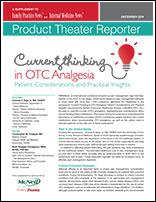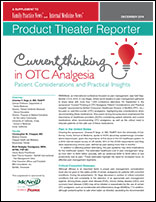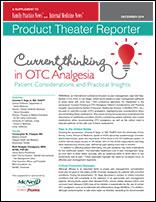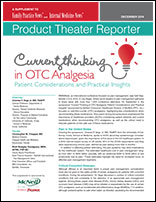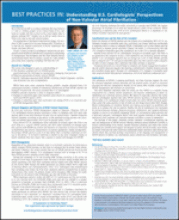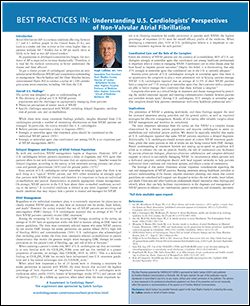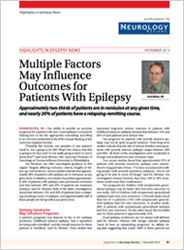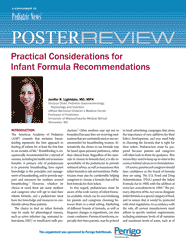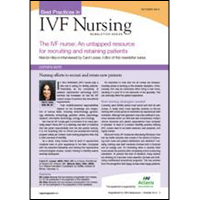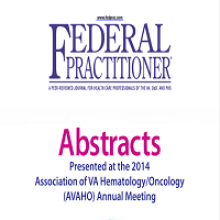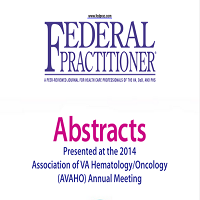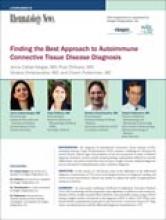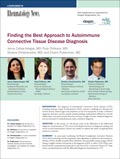User login
Current Thinking in OTC Analgesia: Patient Considerations and Practical Insights
December 2014
A supplement to Family Practice News® and Internal Medicine News®. This supplement is sponsored by McNeil Consumer Healthcare Division of McNEIL-PPC, Inc.
Topics
- Pain in the United States
- Critical Comorbid Illnesses
- Impact of Pain on Comorbidities and Patient Outcomes
- Pain Management for Patients Taking Concomitant Medications
- Benefits of OTC Analgesics
- Risks of OTC Analgesics
- A Nursing Perspective
- Not All Analgesics Are Appropriate for Every Patient
- Patients’ Safe Use of OTC Analgesics
- Conclusions
Faculty
Chairman
Charles P. Vega, Jr, MD, FAAFP
Clinical Professor, Department of Family Medicine
Director, Patient-Centered Advanced Clinical Education
Director, Program in Medical Education for the Latino Community
University of California, Irvine, School of Medicine
Irvine, California
Faculty
Christopher M. Chappel, MD
Medical Director
Chappel Health and Wellness
Kissimmee, Florida
Brett Badgley Snodgrass, MSN, APRN, FNP-BC
Family Nurse Practitioner
Saint Francis Hospital–Bartlett Interventional Pain Management Clinic
Chief Executive Officer and President
BBS Consultants, Inc.
Bartlett, Tennessee
Copyright © 2014 by Frontline Medical Communications Inc.
December 2014
A supplement to Family Practice News® and Internal Medicine News®. This supplement is sponsored by McNeil Consumer Healthcare Division of McNEIL-PPC, Inc.
Topics
- Pain in the United States
- Critical Comorbid Illnesses
- Impact of Pain on Comorbidities and Patient Outcomes
- Pain Management for Patients Taking Concomitant Medications
- Benefits of OTC Analgesics
- Risks of OTC Analgesics
- A Nursing Perspective
- Not All Analgesics Are Appropriate for Every Patient
- Patients’ Safe Use of OTC Analgesics
- Conclusions
Faculty
Chairman
Charles P. Vega, Jr, MD, FAAFP
Clinical Professor, Department of Family Medicine
Director, Patient-Centered Advanced Clinical Education
Director, Program in Medical Education for the Latino Community
University of California, Irvine, School of Medicine
Irvine, California
Faculty
Christopher M. Chappel, MD
Medical Director
Chappel Health and Wellness
Kissimmee, Florida
Brett Badgley Snodgrass, MSN, APRN, FNP-BC
Family Nurse Practitioner
Saint Francis Hospital–Bartlett Interventional Pain Management Clinic
Chief Executive Officer and President
BBS Consultants, Inc.
Bartlett, Tennessee
Copyright © 2014 by Frontline Medical Communications Inc.
December 2014
A supplement to Family Practice News® and Internal Medicine News®. This supplement is sponsored by McNeil Consumer Healthcare Division of McNEIL-PPC, Inc.
Topics
- Pain in the United States
- Critical Comorbid Illnesses
- Impact of Pain on Comorbidities and Patient Outcomes
- Pain Management for Patients Taking Concomitant Medications
- Benefits of OTC Analgesics
- Risks of OTC Analgesics
- A Nursing Perspective
- Not All Analgesics Are Appropriate for Every Patient
- Patients’ Safe Use of OTC Analgesics
- Conclusions
Faculty
Chairman
Charles P. Vega, Jr, MD, FAAFP
Clinical Professor, Department of Family Medicine
Director, Patient-Centered Advanced Clinical Education
Director, Program in Medical Education for the Latino Community
University of California, Irvine, School of Medicine
Irvine, California
Faculty
Christopher M. Chappel, MD
Medical Director
Chappel Health and Wellness
Kissimmee, Florida
Brett Badgley Snodgrass, MSN, APRN, FNP-BC
Family Nurse Practitioner
Saint Francis Hospital–Bartlett Interventional Pain Management Clinic
Chief Executive Officer and President
BBS Consultants, Inc.
Bartlett, Tennessee
Copyright © 2014 by Frontline Medical Communications Inc.
Current Thinking in OTC Analgesia: Patient Considerations and Practical Insights
December 2014
A supplement to Family Practice News® and Internal Medicine News®. This supplement is sponsored by McNeil Consumer Healthcare Division of McNEIL-PPC, Inc.
Click here to open the supplement
Topics
- Pain in the United States
- Critical Comorbid Illnesses
- Impact of Pain on Comorbidities and Patient Outcomes
- Pain Management for Patients Taking Concomitant Medications
- Benefits of OTC Analgesics
- Risks of OTC Analgesics
- A Nursing Perspective
- Not All Analgesics Are Appropriate for Every Patient
- Patients’ Safe Use of OTC Analgesics
- Conclusions
Faculty
Chairman
Charles P. Vega, Jr, MD, FAAFP
Clinical Professor, Department of Family Medicine
Director, Patient-Centered Advanced Clinical Education
Director, Program in Medical Education for the Latino Community
University of California, Irvine, School of Medicine
Irvine, California
Faculty
Christopher M. Chappel, MD
Medical Director
Chappel Health and Wellness
Kissimmee, Florida
Brett Badgley Snodgrass, MSN, APRN, FNP-BC
Family Nurse Practitioner
Saint Francis Hospital–Bartlett Interventional Pain Management Clinic
Chief Executive Officer and President
BBS Consultants, Inc.
Bartlett, Tennessee
Copyright © 2014 by Frontline Medical Communications Inc.
December 2014
A supplement to Family Practice News® and Internal Medicine News®. This supplement is sponsored by McNeil Consumer Healthcare Division of McNEIL-PPC, Inc.
Click here to open the supplement
Topics
- Pain in the United States
- Critical Comorbid Illnesses
- Impact of Pain on Comorbidities and Patient Outcomes
- Pain Management for Patients Taking Concomitant Medications
- Benefits of OTC Analgesics
- Risks of OTC Analgesics
- A Nursing Perspective
- Not All Analgesics Are Appropriate for Every Patient
- Patients’ Safe Use of OTC Analgesics
- Conclusions
Faculty
Chairman
Charles P. Vega, Jr, MD, FAAFP
Clinical Professor, Department of Family Medicine
Director, Patient-Centered Advanced Clinical Education
Director, Program in Medical Education for the Latino Community
University of California, Irvine, School of Medicine
Irvine, California
Faculty
Christopher M. Chappel, MD
Medical Director
Chappel Health and Wellness
Kissimmee, Florida
Brett Badgley Snodgrass, MSN, APRN, FNP-BC
Family Nurse Practitioner
Saint Francis Hospital–Bartlett Interventional Pain Management Clinic
Chief Executive Officer and President
BBS Consultants, Inc.
Bartlett, Tennessee
Copyright © 2014 by Frontline Medical Communications Inc.
December 2014
A supplement to Family Practice News® and Internal Medicine News®. This supplement is sponsored by McNeil Consumer Healthcare Division of McNEIL-PPC, Inc.
Click here to open the supplement
Topics
- Pain in the United States
- Critical Comorbid Illnesses
- Impact of Pain on Comorbidities and Patient Outcomes
- Pain Management for Patients Taking Concomitant Medications
- Benefits of OTC Analgesics
- Risks of OTC Analgesics
- A Nursing Perspective
- Not All Analgesics Are Appropriate for Every Patient
- Patients’ Safe Use of OTC Analgesics
- Conclusions
Faculty
Chairman
Charles P. Vega, Jr, MD, FAAFP
Clinical Professor, Department of Family Medicine
Director, Patient-Centered Advanced Clinical Education
Director, Program in Medical Education for the Latino Community
University of California, Irvine, School of Medicine
Irvine, California
Faculty
Christopher M. Chappel, MD
Medical Director
Chappel Health and Wellness
Kissimmee, Florida
Brett Badgley Snodgrass, MSN, APRN, FNP-BC
Family Nurse Practitioner
Saint Francis Hospital–Bartlett Interventional Pain Management Clinic
Chief Executive Officer and President
BBS Consultants, Inc.
Bartlett, Tennessee
Copyright © 2014 by Frontline Medical Communications Inc.
Understanding U.S. Cardiologists’ Perspectives on Non-Valvular Atrial Fibrillation (NVAF)
A supplement to Cardiology News. This supplement was sponsored by Daiichi Sankyo Inc.
Faculty:
Hugh Calkins, MD, FHRS, Immediate Past President of The Heart Rhythm Society; Director of Cardiac Arrhythmia Service, Johns Hopkins Hospital; and Professor of Medicine at Johns Hopkins University School of Medicine, Baltimore, MD
Disclosures:
Daiichi Sankyo has provided financial support to the Heart Rhythm Society for conducting this survey. Dr. Calkins consults on behalf of Daiichi Sankyo.
A supplement to Cardiology News. This supplement was sponsored by Daiichi Sankyo Inc.
Faculty:
Hugh Calkins, MD, FHRS, Immediate Past President of The Heart Rhythm Society; Director of Cardiac Arrhythmia Service, Johns Hopkins Hospital; and Professor of Medicine at Johns Hopkins University School of Medicine, Baltimore, MD
Disclosures:
Daiichi Sankyo has provided financial support to the Heart Rhythm Society for conducting this survey. Dr. Calkins consults on behalf of Daiichi Sankyo.
A supplement to Cardiology News. This supplement was sponsored by Daiichi Sankyo Inc.
Faculty:
Hugh Calkins, MD, FHRS, Immediate Past President of The Heart Rhythm Society; Director of Cardiac Arrhythmia Service, Johns Hopkins Hospital; and Professor of Medicine at Johns Hopkins University School of Medicine, Baltimore, MD
Disclosures:
Daiichi Sankyo has provided financial support to the Heart Rhythm Society for conducting this survey. Dr. Calkins consults on behalf of Daiichi Sankyo.
Highlights in Epilepsy News
This supplement highlights recent clinical research news in epilepsy culled from national medical conferences.
Click here to download the PDF.
This supplement highlights recent clinical research news in epilepsy culled from national medical conferences.
Click here to download the PDF.
This supplement highlights recent clinical research news in epilepsy culled from national medical conferences.
Click here to download the PDF.
Practical Considerations for Infant Formula Recommendations
This educational supplement to Pediatric News was sponsored by Perrigo Nutritionals.
Topics
- Introduction
- Switching Infant Formula
- Conclusion
Faculty/Faculty Disclosures
Jenifer R. Lightdale, MD, MPH
Division Chief, Pediatric Gastroenterology,
Hepatology and Nutrition
UMass Memorial Children’s Medical Center
Professor of Pediatrics
University of Massachusetts Medical School
Worcester, MA
Dr. Lightdale reports that she is on the medical advisory board for Perrigo Company plc, and is an invited speaker for Mead Johnson & Company, LLC.
This educational supplement to Pediatric News was sponsored by Perrigo Nutritionals.
Topics
- Introduction
- Switching Infant Formula
- Conclusion
Faculty/Faculty Disclosures
Jenifer R. Lightdale, MD, MPH
Division Chief, Pediatric Gastroenterology,
Hepatology and Nutrition
UMass Memorial Children’s Medical Center
Professor of Pediatrics
University of Massachusetts Medical School
Worcester, MA
Dr. Lightdale reports that she is on the medical advisory board for Perrigo Company plc, and is an invited speaker for Mead Johnson & Company, LLC.
This educational supplement to Pediatric News was sponsored by Perrigo Nutritionals.
Topics
- Introduction
- Switching Infant Formula
- Conclusion
Faculty/Faculty Disclosures
Jenifer R. Lightdale, MD, MPH
Division Chief, Pediatric Gastroenterology,
Hepatology and Nutrition
UMass Memorial Children’s Medical Center
Professor of Pediatrics
University of Massachusetts Medical School
Worcester, MA
Dr. Lightdale reports that she is on the medical advisory board for Perrigo Company plc, and is an invited speaker for Mead Johnson & Company, LLC.
Best Practices in IVF Nursing: The IVF nurse—An untapped resource for recruiting and retaining patients
Click here to download the PDF.
In vitro fertilization (IVF) nurses play a vital role in caring for fertility patients. Predictably, as the complexity of assisted reproductive technology (ART) services has increased, so has the IVF nurse’s scope of practice and educational requirements.
Their multidimensional responsibilities depend on the knowledge and integration of various fields, including endocrinology, gynecology, obstetrics, embryology, genetics, ethics, psychology, research, information technology, urology, and oncology.
But how do IVF nurses gain a command of so many specialty areas?
Click here to download the PDF.
In vitro fertilization (IVF) nurses play a vital role in caring for fertility patients. Predictably, as the complexity of assisted reproductive technology (ART) services has increased, so has the IVF nurse’s scope of practice and educational requirements.
Their multidimensional responsibilities depend on the knowledge and integration of various fields, including endocrinology, gynecology, obstetrics, embryology, genetics, ethics, psychology, research, information technology, urology, and oncology.
But how do IVF nurses gain a command of so many specialty areas?
Click here to download the PDF.
In vitro fertilization (IVF) nurses play a vital role in caring for fertility patients. Predictably, as the complexity of assisted reproductive technology (ART) services has increased, so has the IVF nurse’s scope of practice and educational requirements.
Their multidimensional responsibilities depend on the knowledge and integration of various fields, including endocrinology, gynecology, obstetrics, embryology, genetics, ethics, psychology, research, information technology, urology, and oncology.
But how do IVF nurses gain a command of so many specialty areas?
Abstracts Presented at the 2014 AVAHO Annual Meeting
Incorporating hereditary cancer syndrome screening into daily practice
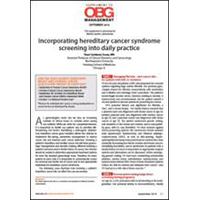
Click here to download the PDF.
Shari Goldman Snow, MD
Assistant Professor of Clinical Obstetrics and Gynecology
Northwestern University
Feinberg School of Medicine
Chicago, IL
Dr. Snow reports that she is a consultant and speaker for Myriad Genetics Laboratories.
As gynecologists, every day we face an increasing number of clinical issues to consider when seeing our patients. While we strive for comprehensiveness, it is important to stratify our patient care to prioritize life-threatening risk factors. Identifying a pathogenic (deleterious) hereditary cancer gene mutation allows the clinician to implement life-saving, preventive management to reduce cancer risk and improve early cancer detection. Knowing a patient’s hereditary and familial cancer risk will drive gynecologic management and decision making. Without knowing a patient’s personal and/or family history of cancer, the clinician would be unable to determine appropriate treatment options for even the simplest gynecologic issue. Therefore, for every patient at every visit, it is imperative to systematically screen for personal and family risk of cancer and to test appropriate individuals for hereditary cancer syndromes.
The following cases illustrate how knowing a patient’s hereditary cancer risk can affect the care we provide.
CASE 1: Managing fibroids—and cancer risk—in a patient with BRCA1 mutation
YH is a 40-year-old patient, G0P0, who presented for a second opinion regarding large uterine fibroids. Her previous gynecologist treated the fibroids conservatively with medication and a dilation and curettage (D&C) procedure. The patient’s menorrhagia became severe, however, leading to anemia. A hysterectomy was recommended, but the patient wanted a second opinion to discuss options for preserving her uterus.
Assistant Professor of Clinical Obstetrics and Gynecology
Northwestern University
Feinberg School of Medicine
Chicago, IL

Click here to download the PDF.
Shari Goldman Snow, MD
Assistant Professor of Clinical Obstetrics and Gynecology
Northwestern University
Feinberg School of Medicine
Chicago, IL
Dr. Snow reports that she is a consultant and speaker for Myriad Genetics Laboratories.
As gynecologists, every day we face an increasing number of clinical issues to consider when seeing our patients. While we strive for comprehensiveness, it is important to stratify our patient care to prioritize life-threatening risk factors. Identifying a pathogenic (deleterious) hereditary cancer gene mutation allows the clinician to implement life-saving, preventive management to reduce cancer risk and improve early cancer detection. Knowing a patient’s hereditary and familial cancer risk will drive gynecologic management and decision making. Without knowing a patient’s personal and/or family history of cancer, the clinician would be unable to determine appropriate treatment options for even the simplest gynecologic issue. Therefore, for every patient at every visit, it is imperative to systematically screen for personal and family risk of cancer and to test appropriate individuals for hereditary cancer syndromes.
The following cases illustrate how knowing a patient’s hereditary cancer risk can affect the care we provide.
CASE 1: Managing fibroids—and cancer risk—in a patient with BRCA1 mutation
YH is a 40-year-old patient, G0P0, who presented for a second opinion regarding large uterine fibroids. Her previous gynecologist treated the fibroids conservatively with medication and a dilation and curettage (D&C) procedure. The patient’s menorrhagia became severe, however, leading to anemia. A hysterectomy was recommended, but the patient wanted a second opinion to discuss options for preserving her uterus.

Click here to download the PDF.
Shari Goldman Snow, MD
Assistant Professor of Clinical Obstetrics and Gynecology
Northwestern University
Feinberg School of Medicine
Chicago, IL
Dr. Snow reports that she is a consultant and speaker for Myriad Genetics Laboratories.
As gynecologists, every day we face an increasing number of clinical issues to consider when seeing our patients. While we strive for comprehensiveness, it is important to stratify our patient care to prioritize life-threatening risk factors. Identifying a pathogenic (deleterious) hereditary cancer gene mutation allows the clinician to implement life-saving, preventive management to reduce cancer risk and improve early cancer detection. Knowing a patient’s hereditary and familial cancer risk will drive gynecologic management and decision making. Without knowing a patient’s personal and/or family history of cancer, the clinician would be unable to determine appropriate treatment options for even the simplest gynecologic issue. Therefore, for every patient at every visit, it is imperative to systematically screen for personal and family risk of cancer and to test appropriate individuals for hereditary cancer syndromes.
The following cases illustrate how knowing a patient’s hereditary cancer risk can affect the care we provide.
CASE 1: Managing fibroids—and cancer risk—in a patient with BRCA1 mutation
YH is a 40-year-old patient, G0P0, who presented for a second opinion regarding large uterine fibroids. Her previous gynecologist treated the fibroids conservatively with medication and a dilation and curettage (D&C) procedure. The patient’s menorrhagia became severe, however, leading to anemia. A hysterectomy was recommended, but the patient wanted a second opinion to discuss options for preserving her uterus.
Assistant Professor of Clinical Obstetrics and Gynecology
Northwestern University
Feinberg School of Medicine
Chicago, IL
Assistant Professor of Clinical Obstetrics and Gynecology
Northwestern University
Feinberg School of Medicine
Chicago, IL
Finding the Best Approach to Autoimmune Connective Tissue Disease Diagnosis
Jenny Cabas-Vargas, MD
Rheumatologist
Institute for Rheumatic and Autoimmune Diseases
Overlook Medical Center
Summit, New Jersey
Puja Chitkara, MD
Rheumatologist
Center for Arthritis and Rheumatologic Excellence (CARE)
San Diego, California
Stratos Christianakis, MD
Rheumatologist
Assistant Professor of Clinical Medicine
Keck School of Medicine of USC
Los Angeles, California
Chaim Putterman, MD
Professor of Medicine
(Rheumatology) and Microbiology & Immunology
Chief, Division of Rheumatology
Albert Einstein College of Medicine
Bronx, New York
Part 1
Part 2
Part 3
Part 4
Part 5
Part 6
Part 7
Part 8
Jenny Cabas-Vargas, MD
Rheumatologist
Institute for Rheumatic and Autoimmune Diseases
Overlook Medical Center
Summit, New Jersey
Puja Chitkara, MD
Rheumatologist
Center for Arthritis and Rheumatologic Excellence (CARE)
San Diego, California
Stratos Christianakis, MD
Rheumatologist
Assistant Professor of Clinical Medicine
Keck School of Medicine of USC
Los Angeles, California
Chaim Putterman, MD
Professor of Medicine
(Rheumatology) and Microbiology & Immunology
Chief, Division of Rheumatology
Albert Einstein College of Medicine
Bronx, New York
Part 1
Part 2
Part 3
Part 4
Part 5
Part 6
Part 7
Part 8
Jenny Cabas-Vargas, MD
Rheumatologist
Institute for Rheumatic and Autoimmune Diseases
Overlook Medical Center
Summit, New Jersey
Puja Chitkara, MD
Rheumatologist
Center for Arthritis and Rheumatologic Excellence (CARE)
San Diego, California
Stratos Christianakis, MD
Rheumatologist
Assistant Professor of Clinical Medicine
Keck School of Medicine of USC
Los Angeles, California
Chaim Putterman, MD
Professor of Medicine
(Rheumatology) and Microbiology & Immunology
Chief, Division of Rheumatology
Albert Einstein College of Medicine
Bronx, New York
Part 1
Part 2
Part 3
Part 4
Part 5
Part 6
Part 7
Part 8
